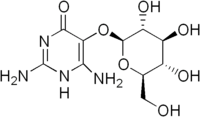Vicine
Vicine is an alkaloid glycoside found mainly in fava beans (Vicia faba).[1] Vicine is toxic in individuals who have a hereditary loss of the enzyme glucose-6-phosphate dehydrogenase. It causes haemolytic anaemia, called favism. The formation of vicine in Vicia faba has been studied, but this natural formation has not yet been found.[2]
 | |
| Names | |
|---|---|
| IUPAC name
2,6-Diamino-5-[(2S,3R,4S,5S,6R)-3,4,5-trihydroxy-6-(hydroxymethyl)-2-tetrahydropyranyl]oxy]-1H-pyrimidin-4-one | |
| Identifiers | |
3D model (JSmol) |
|
| ChemSpider | |
| ECHA InfoCard | 100.005.283 |
PubChem CID |
|
| UNII | |
CompTox Dashboard (EPA) |
|
| |
| |
| Properties | |
| C10H16N4O7 | |
| Molar mass | 304.259 g·mol−1 |
Except where otherwise noted, data are given for materials in their standard state (at 25 °C [77 °F], 100 kPa). | |
| Infobox references | |
History
Vicine was initially isolated in 1870 from the seeds of Vicia sativa by a method of extraction with sulfuric acid and subsequent precipitation with mercury sulfate (HgSO4). Later vicine was also found in other Vicia species, namely Vicia faba, beet juice and peas. The chemical structure of the compound was built gradually. First the glycosidic nature of the compound was recognized in 1896. The same year the aglycone of vicine, divicine, was isolated. In the beginning of the 20th century the pyrimidine structure was recognized. Despite these initial successes, the correct formula of vicine was determined only in 1953 and it is 2,4-diamino-6-oxypyrimidine-5-(ß-d-glucopyranoside).[2]
Metabolism
Vicine is an inactive compound in the body. When vicine enters the body through food, it is hydrolysed by the intestinal microflora to a highly reactive free radical generating compound, the aglycone divicine.[2] Upon hydrolysis, the glucose part of the molecule is split off and that results in the reduced divicine. Divicine is then taken up in the blood through the intestinal epithelium.[3][4]
Adverse effects
Adverse effects almost solely occur in humans that suffer from glucose-6-phosphate dehydrogenase deficiency. This deficiency causes a shortage of glutathione in erythrocytes and glutathione is needed for the neutralization of ROS (reactive oxygen species) created by the strongly reducing agent divicine.[4]
Toxicity
The β-glycosidic bond between glucose and the hydroxyl group at C5 on the pyrimidine ring are hydrolysed to yield the aglycone of vicine, divicine (2,6-diamino-4,5-dihydroxypyrimidine).[5] These aglycones have a strong oxidising capacity for glutathione.[6] In healthy individuals, this is not a problem, as glutathione can be reduced quickly enough to regenerate it. In individuals with a deficiency for glucose 6-phosphate dehydrogenase (G6PD) however, this results in haemolytic anaemia.[7]
Effects on animals
A 10 g vicine /kg diet in laying hens led to reduced feed intake, egg weight, haemoglobin levels and fertility and increased liver weights, liver glutathione levels and plasma lipid levels. A diet with comparable levels of vicine per kg in pigs showed only small effects on protein and energy digestibility.[8]
In another study, laying and broiler hens were fed grains that were soaked for different periods of time, which partly or totally removed vicine. Hens that had had grains with vicine still in them showed a significant decrease in corpuscular haemoglobin, while the others did not.[9]
An in vivo study in rats showed that oral administration of vicine resulted in only small reductions in glutathione concentrations and no mortality. Intraperitoneal administration however, led to a rapid decrease in glutathione followed by death because of anoxia.[10]
References
- Lattanzio V, Bianco VV, Crivelli G, Miccolis V (May 1983). "Variability of Amino Acids, Protein, Vicine and Convicine in Vicia faba (L) Cultivars". Journal of Food Science. 48 (3): 992–993. doi:10.1111/j.1365-2621.1983.tb14950.x.
- Mager J, Razin A, Herschko A (1969). "Favism". In Liener I (ed.). Toxic constituents of plant foodstuffs. New York: Academic Press. pp. 293–312.
- Baker MA, Bosia A, Pescarmona G, Turrini F, Arese P (June 1984). "Mechanism of action of divicine in a cell-free system and in glucose-6-phosphate dehydrogenase-deficient red cells". Toxicologic Pathology. 12 (4): 331–6. doi:10.1177/019262338401200405. PMID 6099911.
- Luzzatto L, Arese P (January 2018). "Favism and Glucose-6-Phosphate Dehydrogenase Deficiency". The New England Journal of Medicine. 378 (1): 60–71. doi:10.1056/NEJMra1708111. PMID 29298156.
- Rizzello CG, Losito I, Facchini L, Katina K, Palmisano F, Gobbetti M, Coda R (August 2016). "Degradation of vicine, convicine and their aglycones during fermentation of faba bean flour". Scientific Reports. 6 (1): 32452. doi:10.1038/srep32452. PMC 5006014. PMID 27578427.
- Mager J, Glaser G, Razin A, Izak G, Bien S, Noam M (July 1965). "Metabolic effects of pyrimidines derived from fava bean glycosides on human erythrocytes deficient in glucose-6-phosphate dehydrogenase". Biochemical and Biophysical Research Communications. 20 (2): 235–40. doi:10.1016/0006-291x(65)90352-9. PMID 5850686.
- Pulkkinen M, Zhou X, Lampi AM, Piironen V (December 2016). "Determination and stability of divicine and isouramil produced by enzymatic hydrolysis of vicine and convicine of faba bean". Food Chemistry. 212: 10–9. doi:10.1016/j.foodchem.2016.05.077. PMID 27374500.
- Jezierny D, Mosenthin R, Bauer E (May 2010). "The use of grain legumes as a protein source in pig nutrition: A review". Animal Feed Science and Technology. 157 (3–4): 111–128. doi:10.1016/j.anifeedsci.2010.03.001.
- Farran MT, Darwish AH, Uwayjan MG, Sleiman FT, Ashkarian VM (June 2002). "Vicine and convicine in common vetch (Vicia sativa) seeds enhance beta-cyanoalanine toxicity in male broiler chicks". International Journal of Toxicology. 21 (3): 201–9. doi:10.1080/10915810290096333. PMID 12055021.
- Arbid MS, Koriem KM, Asaad GF, Megahed HA (2013). "Effect of the antibiotic neomycin on the toxicity of the glycoside vicine in rats". Journal of Toxicology. 2013: 913128. doi:10.1155/2013/913128. PMC 3694484. PMID 23840205.